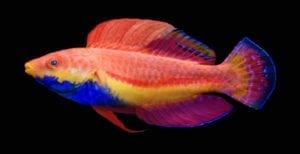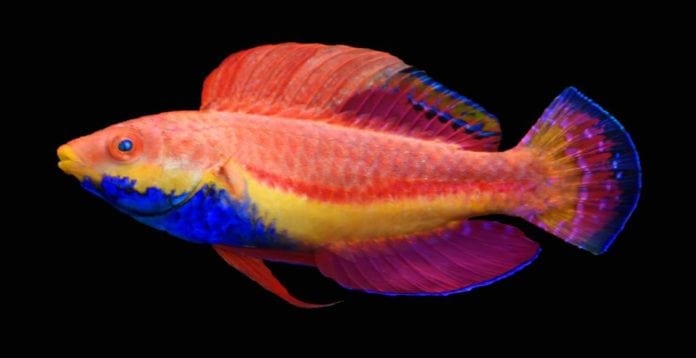Care Recommendations for the Sailfin Fairy Wrasse – Cirrhilabrus cyanogularis
By Christeena
- Care Level: Easy
- Temperament: Peaceful
- Diet: Carnivore
- Reef Safe: Yes
- Max Size: 5 inches
- Minimum Tank Size: 70 gallons

The colorfully majestic Sailfin Fairy Wrasse used to be an unidentified species but has recently been classified into a new species name, Cirrhilabrus cyanogularis. These fish are native to the waters off the coasts of Indonesia and the Philippines. As with other wrasse fish, the Sailfin Fairy is beautifully adorned with amazing colors. It has flowing red-orange fins, some with purple accents and their body has hints of red, orange, and yellow coloring. In addition to the beautiful colors, the Sailfin Fairy has a vibrant electric blue coloring on its chin. Until recently, all these beautiful characteristics were thought to be mutations or a hybrid of other fairy wrasse species.
Tank Requirements for Sailfin Fairy Wrasse
The colorful Sailfin Fairy Wrasse is a great addition to your reef tank. The tank should be around 70 gallons and contain sandy substrate with a good amount of live rock for hiding and exploring. Similar to all other wrasse species, it’s important to have a tight-fitting, secure lid on your tank to prevent escape. As with many wrasse species, make sure the tank is at least 150 gallons if several species of wrasse fish will be in the same aquarium. Also, do not pair them with aggressive or territorial fish.
Feeding Habits of Sailfin Fairy Wrasse
With a carnivorous diet, feed your Sailfin Fairy zooplankton, brine and mysis shrimp, and quality pellet and flake food. Several feedings a day should be adequate to keep your wrasse happy. Since this fish is easy enough for beginning aquarist, this species would be a unique and rare treat for any hobbyist.
Keep Sailfin Fairy Wrasse fish in a good environment and a temperature between 72 and 78°F. Maintain a pH value of 8.1-8.4, a salinity of between 1.020-1.025, nitrates and ammonia levels at 0 ppm, and dKH between 8-12.
Learn more about caring for Wrasses

















